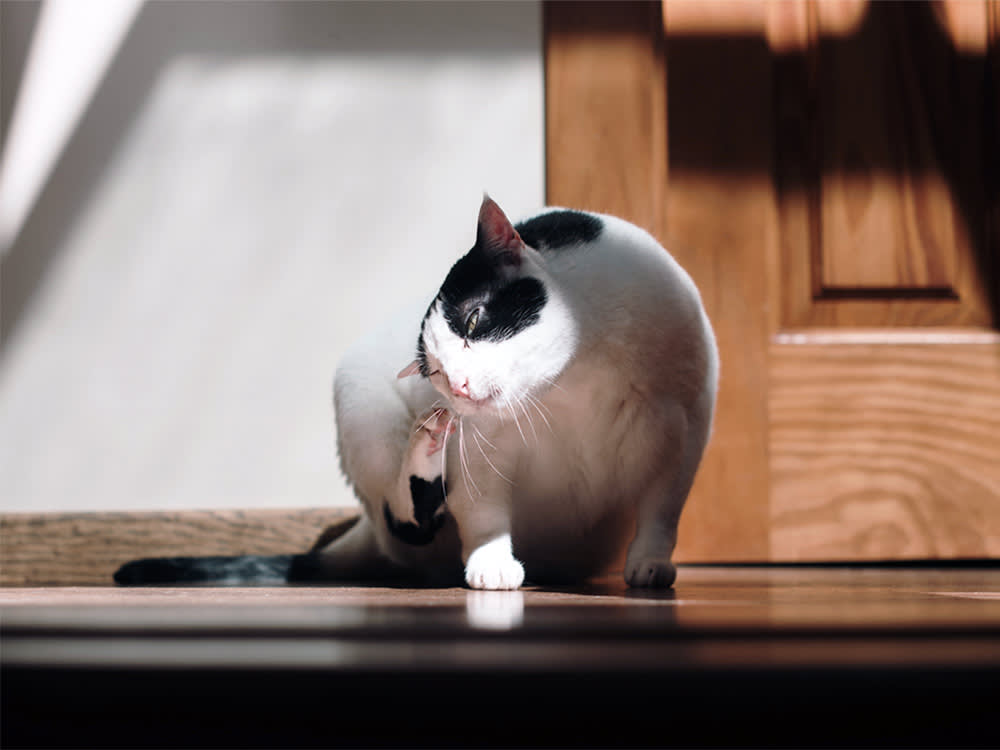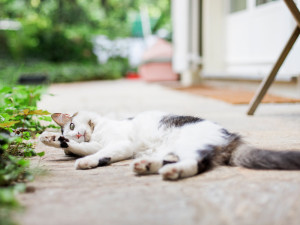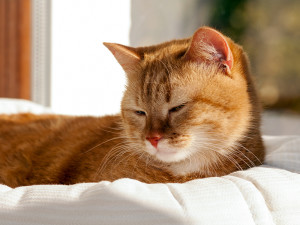Ringworms in Cats: Symptoms, Treatment, and Prognosis
Well, it’s not a fun thing to deal with, for starters.

share article
In This Article:
Signs of Ringworm in Catsopens in a new tab Modes of Transmissionopens in a new tab Diagnosing Ringwormopens in a new tab Treatment Options opens in a new tab Preventing Ringworm Spreadopens in a new tab Follow-Up Careopens in a new tab
Ringworm in cats is a highly contagious skin infection, leading to scaly skin, hair loss, and itching, seen primarily on the head, ears, and forelimbs. Ringworm treatment in cats includes topical and oral antifungal medication regimens and thorough home-cleaningopens in a new tab to kill the infectious fungal spores.
What’s a ringworm?
More than a few unlucky cat-lovers have had the experience of snuggling with an adorable kitten, only to develop a few scaly skin lesions a week or so later. “Ugh, it’s ringworm,” you groan. Despite its misleading name, ringworm is a contagious fungal infection, not a worm. It’s a common skin condition that can affect many animals, including cats, dogs, and humans. Dermatophytosis, the fancy name for having ringworm, is most frequently caused in cats by the fungus Microsporum canis.
Signs of ringworm in cats
Dermatophytosis is commonly called ringworm because of the classic ring-like lesion that it tends to cause on the skin. The signs and symptoms of ringworm in cats can vary in severity, ranging from mild crustiness to nasty, oozing skin lesions. Some cats carry ringworm without showing any symptoms. Skin lesions tend to develop on the head, face, and front limbs.
Signs of ringworm in cats include:
Patchy, circular hair loss
Broken hairs
Redness
Crusts and scalesopens in a new tab (dandruff)
Scabs
Sores
Itchiness
Ringworm modes of transmission
Animals harboring ringworm carry infectious spores on their hair and skin that can be transferred to other animals, objects, or soil. Tracing the origin of an infection may sometimes be challenging because fungal spores can stay in the environment for well over a year, and some cats can be asymptomatic carriers. Ways that cats pick up this highly contagious infection include:
Direct contact with an infected animal
Sleeping on contaminated bedding
Contact with contaminated surfaces
Being groomed with contaminated tools (brushes, clippers)
Digging in soil contaminated with dermatophyte spores
Cat parents should know that ringworm is zoonotic, meaning your cat can pass this fungal infection on to you. Children, elderly, and immunocompromised people have the highest risk.
Risk factors for ringworm in cats
Not every cat who has contact with dermatophytes will develop ringworm, but some cats have a higher risk of infection.
Risk factors for ringworm include:
Age: Kittens are more susceptible to ringworm infection.
Health status: Cats with compromised immune systems, like those with feline immunodeficiency virus (FIV) or feline leukemia (FeLV), have a higher risk.
Outdoor roaming: Cats who roam outdoors have a higher risk of exposure to dermatophytes in the environment.
Warm weather: Ringworm tends to thrive in warm, humid environments.
Traumatized skin: Broken skin acts as an open door for dermatophytes. Cats who are constantly scratching due to other skin parasites (like fleas and ear mites) are more susceptible to getting ringworm.
How is feline ringworm diagnosed?
Ringworm in cats is diagnosed with a combination of physical exam findings and diagnostic testing. While reporting to your veterinarian “my kitten got crusty and now I’m crusty too” may narrow down the list of possible causes, testing should be performed to confirm the diagnosis. Options include:
Fungal culture
Brushing is used to collect hair and skin samples to be placed on a special culture plate called Dermatophyte Test Media (DTM). The sample is monitored for two to three weeks to determine if any dermatophytes grow. Although time-consuming, taking a culture is considered the most accurate method for diagnosing ringworm, as it also helps identify the species of fungus, which is helpful when determining the best course of treatment.
Wood’s lamp
Hair and skin infected with ringworm fungi will often glow a bright green color under ultraviolet (UV) light. This is an easy screening tool that can be performed in an exam room. But ringworm doesn’t always glow under UV light, so it’s not a fool-proof method for diagnosis.
Microscopic examination
Plucked hairs can be evaluated under a microscope for fungal spores or hyphae. Fungal structures can be difficult to detect, so this isn’t always the diagnostic test of choice.
PCR testing
Polymerase chain reaction (PCR) testing can be used to detect fungal DNA. This technique is best used to confirm infection on a cat that has not been treated yet. PCR testing is super sensitive and can also detect the DNA of dead fungus, which can be found on cats that have already undergone successful treatment.
Biopsy
Skin biopsy may be recommended in cases where cats develop severe or atypical lesions, such as ulcerated skin.
How is feline ringworm treated?
Treating ringworm in cats often involves a combination of topical, oral, and environmental treatments. Healthy cats can sometimes clear a ringworm infection on their own, but this can take months. While a cat’s immune system is working on recovery, the fungus can infect other pets and people in the house. Prompt treatment is recommended because spores continue to be spread in the environment until the infection is under control.
Topical treatments
Topical antifungal treatments, like shampoos, dips, creams, and sprays kill infective spores on the fur and skin. Medicated baths and dips are usually recommended twice a week.
Oral medication
Oral antifungals prevent dermatophytes from reproducing. Itraconazole and terbinafine are the most commonly prescribed medications for feline ringworm. Your veterinarian will recommend the best dosing strategy for your cat.
Cleaning
The environment should be thoroughly cleaned to remove all infected hair. Environmental treatment includes disinfecting surfaces, washing bedding (twice, with bleach), vacuuming, carpet cleaning, and cleaning HVAC filters. Don’t forget grooming tools like brushes and clippers. Think of what it would take to rid your house of cat hair before your allergic in-laws come over. Do that…at least twice.
Home remedies for ringworm in cats can help support treatment, but they are not a replacement for proper care. Clipping the fur is usually not necessary, but some long-haired cats may benefit from clipping to allow topical treatments to work better. Essential oilsopens in a new tab should be avoided due to possible exacerbation of skin irritation and the risk of toxicity.
Preventing ringworm spread
Part of at-home cat ringworm treatment is preventing spread to the people and other pets in the home. Infected cats should be confined to a space that is away from other pets and easy to clean, like a bathroom. This doesn’t mean that cats are locked away and alone for weeks. Even the most aloof cat craves attention, and new kitten parents must strike a balance between confinement and socialization. Cat parents can and should still interact with their cats during treatment.
To keep infections in check, designate a few clothing items to be worn only when playing with your cat, then wash and disinfect them routinely. And always wash your hands after handling a cat with ringworm. Other pets that have had contact with an infected cat should be tested and monitored closely for the development of skin lesions.
Follow-up care
One of the most important aspects of addressing ringworm is to continue treatment until your vet confirms that your cat has been cured. Even if your once-crusty kitten is now soft and fluffy, they can still have infectious spores.
Post-treatment fungal culture is often recommended to ensure a cat has been cured of ringworm and that treatment can be discontinued. To keep your cat (and yourself) ringworm-free: follow your vet’s instructions, monitor your cat’s progress, schedule check-ups, and perform follow-up tests as recommended.
FAQs (People also ask):
How to get rid of ringworms in cats?
Treating ringworm in cats usually involves a combination of topical treatments, oral medications, and thorough environmental cleaning. Infected cats should be confined during treatment.
What are home remedies for ringworm in cats?
There are no recommended home remedies for killing ringworm. The best supportive care is to keep the environment clean and make sure your cat is otherwise healthy and stress-free.
Can humans get ringworm from cats?
Ringworm is zoonotic, meaning humans can get ringworm from cats. People can get ringworm by direct contact with an infected cat or contact with contaminated objects. Children, seniors, and people who are immunocompromised have a higher risk.
References:
Diagnosis and Treatment of Dermatophytosis in Dogs and Catsopens in a new tab
AAFP 2017 — Dermatophytosis: Evidence-Based Medicine for Treatment & Debunking Ringworm Folklore

Dr. Alycia Washington, DVM, MS
Alycia Washington, DVM, is a small animal emergency veterinarian based in North Carolina. She works as a relief veterinarianopens in a new tab and provides services to numerous emergency and specialty hospitals. Dr. Washington is also a children’s book author and freelance writer with a focus on veterinary medicine. She has a special fondness for turtles, honey bees, and penguins — none of which she treats. In her free time, Dr. Washington enjoys travel, good food, and good enough coffee.
Related articles
![Woman petting her long haired cat on the sofa.]() opens in a new tab
opens in a new tabWhy Does My Cat Have Dandruff? Common Causes and Treatments
Ever heard of “walking dandruff?” Yep, that’s what we said.
![a cat licking a hot spot]() opens in a new tab
opens in a new tabHow to Spot, Treat, and Prevent Hot Spots on Your Cat
Hot spots are so not hot—your cat agrees.
![A brunnette woman petting her black cat sitting on her desk while she prepares to give him a pill]() opens in a new tab
opens in a new tabHow to Give a Cat a Pill
Everything you need to know about the difficult task of medicating a cat.
![Siamese cat coughing]() opens in a new tab
opens in a new tabWhy Is My Cat Coughing?
You thought it was a hairball, but nothing’s coming up…
![Uncomfortable looking gray cat sitting on a window sill]() opens in a new tab
opens in a new tabShould Your Cat Go to the ER?
Here are six good reasons to haul tail to the emergency room.
![Red cat with squinted eyes laying in a basket closeup]() opens in a new tab
opens in a new tab6 Ways Your Cat Could Tell You They Are in Pain
Here are all the way your kitty is trying to tell you they’re hurting.










